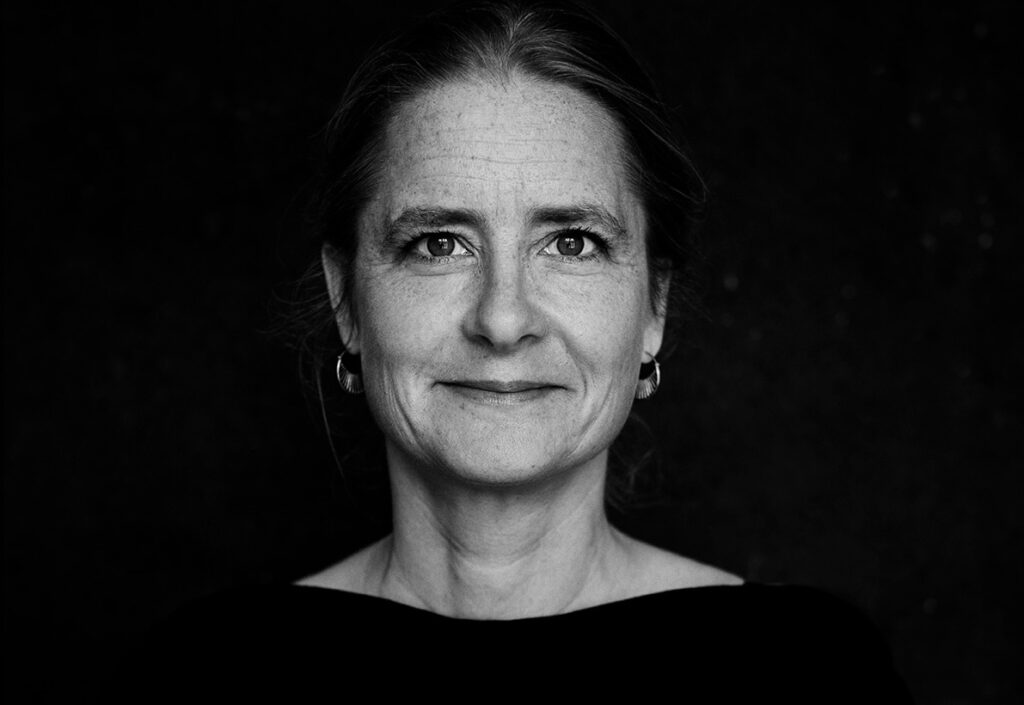Line Vaaben was recruited to the Denmark-based news outlet Politiken in 2021 to carve out a first-of-its-kind position. With no name for it, Vaaben created a title that perfectly encapsulated the storytelling she wished to produce: existential editor.
She and a team of four reporters and an intern formed the existential desk to tell stories about humans, for humans. “It’s a real privilege to be able to go out into the world with curiosity and get to ask questions to other human beings and find out what it’s all about,” Vaaben said.
Vaaben, a 2025 Nieman Fellow and Storyboard contributor, spoke at this year’s Power of Narrative conference at Boston University about the types of stories Politiken’s existential desk produces. I followed up with her afterward to discuss one of Vaaben’s stories from 2024, about patients in a palliative care unit: “There is a moment of silence. Then he whispers: ‘Remember to say goodbye to everyone.’”
Vaaben highlighted six themes the existential desk looks for in its stories:
- Stages of life: These represent the common, pivotal experiences millions of people go through, such as menopause, divorce, aging, and death. Vaaben highlighted a story about a man who suffered from a chronic pulmonary disease and wished to go through self-assisted suicide — a practice that is illegal in Denmark.
- Relationships: This tackles romantic, parental, and social relationships and the tensions within those dynamics. An existential reporter who explored the theme of love wrote about age-gap relationships, heartbreak, and finding love later in life.
- Experiences: Vaaben said following people through experiences like life-changing events, burnout and emotional fatigue, and extraordinary longevity can bring out the most humanity in their stories.
- Abstract concepts: These stories have included topics such as femicide, fear of war, and the loneliness epidemic. In particular, Vaaben pointed to a summer series Politiken published about family secrets, in which people submitted stories about things they keep concealed from their loved ones. Vaaben also highlighted an article she wrote that followed a pig from its birth to its slaughter — and then to her Christmas dinner table.
- Historical perspectives: These stories look back at long-ago events and anchor them to something in the present day. Examples include interviews with the families of fallen soldiers and women who had abortions in the 1950s and '60s when the procedure was legalized in Denmark. Vaaben also revisited a tragic Gothenburg fire and spoke with the same sources she talked to 25 years earlier.
- Revisiting stories: Vaaben emphasized the importance of revisiting stories, to make space for reflection on the past and also allow reporters to reconnect with their subjects. One example that fits this theme is Politiken’s coverage of nurses experiencing long COVID.
Vaaben said her desk’s success comes from blending narrative storytelling, human interest, and newsworthiness. In her 2024 story for Politiken, Vaaben and photographer Jacob Ehrbahn spent 10 days at a palliative care unit that treats terminally ill patients, focusing on the lives of three people: René, Niels, and Liv.
Here's how the story opens:
René Damgaard, 67 years old, lies in a hospital bed in the Palliative Care Unit at Hvidovre Hospital. It’s the first evening of May, and the window is open, letting mild air and the sound of a blackbird singing into room 14.
“This is the kind of weather you love the most. When you usually stand and fish at the sandbank,” says his niece, 53-year-old Mette Damgaard. She is leaning over the bed, her face very close to his. She has been sitting like this for a long time.
René Damgaard has his eyes closed, and his mouth is slightly open. The evening light falls across his gaunt face, and he looks as though he is sleeping. He is not, but he is dying.
“I will take care of you,” Mette whispers.
He nods. She strokes his hand and squeezes it.
“You can let go now, René.”
There is a moment of silence. Then he whispers:
“Remember to say goodbye to everyone from me.”
“I will, René. I promise.”

Vaaben told me how she reported and wrote the story. Our conversation has been edited for length and clarity.
How long did you spend with each of the three patients highlighted in the story? What did your first interactions with them look like?
The first couple of days in the unit, we were just trailing the doctors and nurses during their morning rounds. They were our icebreakers, simply asking — when entering — whether it was OK to bring us along. Gradually, they got to know us, and we started slipping in on our own.
René, Niels, and Liv were all open to having us around, but it took a lot of time to get close. In the beginning, I didn’t ask many questions. I just spent time in the room listening and observing. People who are dying are often very tired and spend much of their time sleeping. So, the pace was incredibly slow, and I just had to be very patient.
Over the course of two weeks, I think I spent a couple of days with each patient in total — though it’s hard to say, since we were there all the time — from early morning until late at night. And on a couple of occasions, we were on call, and rushed back at 2 a.m. because someone was dying. It depended on whether the patients were sleeping, had visitors, or were interacting with doctors and nurses.
We were respectful of their privacy, but the better we got to know them, the more natural it became to spend time in their rooms without any obvious reason. But it was very valuable to me, since I got to witness small, intimate moments — because they almost forgot I was there.
The progression of René’s time at the hospital and the details of his life grabbed me throughout the entire piece. Why did you choose to focus on him for most of the story?
Obviously, we gathered a lot of stories and scenes and met many patients and families who never made it into the published version. Choosing was the hardest part when I sat down to write. But I knew already while I was reporting that René was an obvious choice for the main character.
Not only because we witnessed his entire path in the unit — from his arrival to [his death] — but also because he was very open to having us around. And his niece, Mette, was an incredible person who immediately understood the importance of the story.
When he died and the doctor paid his respects and everyone was crying, I remember thinking: This doesn’t feel like work. I felt like I was bearing witness to an important human experience. I truly felt lucky and honored.
Throughout this piece — and in your other work as well — you include dialogue during highly emotional scenes. How do you achieve being “a fly on the wall” in these moments?
I think it’s very important to think of reporting and interviewing as two separate tools if possible. When I report, I just tag along with my notebook. I don’t ask questions unless it’s strictly necessary. Then, later, I do interviews and ask all the things I’m curious about.
Becoming invisible is something I’ve cultivated for years. In this case, I spent most of those weeks sitting on the floor, hunched over my notebook. Whenever I entered the rooms and had introduced myself, I would settle on the floor with my back to the wall in a corner and just register the smells, the sounds, the light — and of course dialogue and actions. Very quickly, people seemed to forget I was there.
I then did interviews during quiet moments — like when patients were sleeping, I would talk to doctors and families. And I often interviewed the patients while they were having dinner.
How did you gain access to this unit? Were patients aware beforehand that you would be reporting?
It took a long time — many months from when I first approached the hospital until we were allowed to begin reporting. We had numerous meetings with the people in charge. We even visited once just to say hello to the staff and get a tour, without taking notes or photos.
But once everything was settled, it was surprisingly easy, mainly thanks to the staff, who introduced us to the patients by saying: “We have visitors from Politiken writing a story about the unit. Would you mind if they came in and listened to our conversation?”
Obviously some patients said no. But many welcomed us, and then everyone — staff, patients, and families — had to sign a consent form to participate. Not immediately, but before we left the unit. I’d never had to do that before, but I was grateful later, when some of them passed away, knowing that the legal aspects were covered.
We also followed up thoroughly with families before publishing — almost three months after reporting — so they knew when and where their loved ones would appear in print and online.
Since the topic of assisted dying is so controversial in Denmark, how was the piece initially received by readers?
Out of nearly 21,000 articles published on our website last year, this one had the longest average reading time: 5 minutes and 10 seconds. That’s remarkable compared to the 43 seconds people typically spend on an article on our site.
The story was also widely shared, and I received many emails from readers — both those who support and those who oppose assisted dying, as well as from healthcare professionals who appreciated how we portrayed their work.
I think it struck a chord in the public debate, where many people want the right to die because they fear those last weeks and days. The article helped de-mystify the experience, without glorifying it.
Has there been any other legislation related to assisted dying since it was published?
In January 2025, the Committee for a More Dignified Death, appointed by the government, recommended that terminally ill patients with limited time remaining be given the option to end their lives using medication prescribed by a physician.
Now, the Secretary of Health and the government must decide whether to propose a bill. This might happen in the coming fall — and we’ll be covering it, of course.
***
Emilia Wisniewski is a general assignment reporter and engagement editor at the Concord Monitor in New Hampshire. She previously worked at Boston.com and The Boston Globe as a correspondent where she covered local politics, business, health, and environment. She graduated from Boston University in 2025 with a degree in Journalism and Business Administration.



